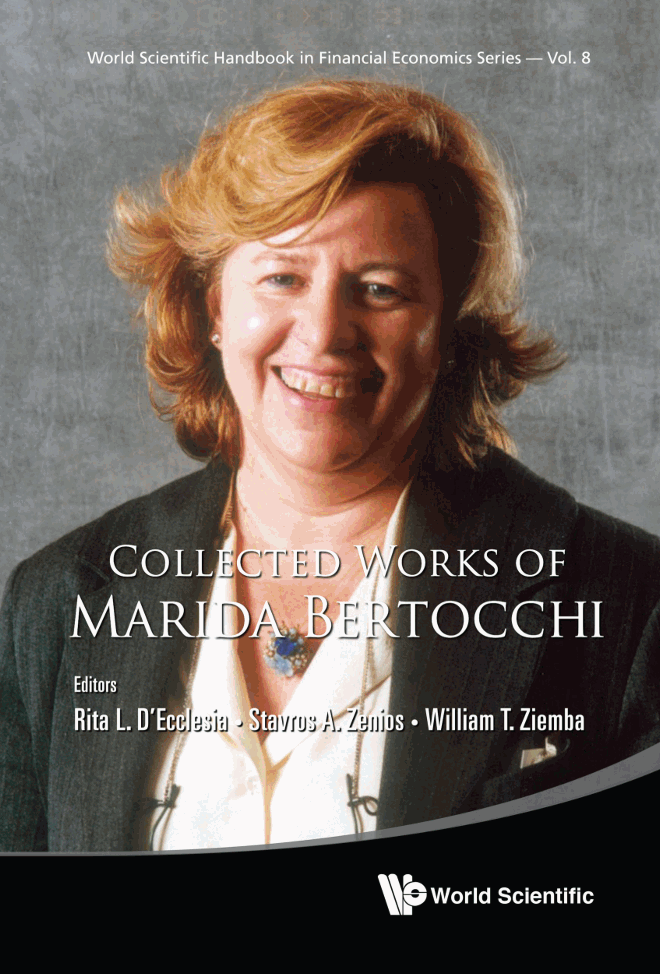
© 2020, World Scientific Publishing
This book aims to celebrate the memory of Marida Bertocchi, Full Professor of Applied Mathematics in Economics and Finance at the University of Bergamo (Italy), who passed away on November 16th 2016, after a short and severe illness. To this aim the Editors complemented a collection of fifteen of her research papers (out of more than 80 publications) with some biographic notes on her career and life.
I will start by recalling the sentence I wrote on the back cover of the book ‘In honor of a unique colleague and reliable friend, this collection of works provides a taste of Marida’s inexhaustible and eclectic research activity’. I believe that this sentence synthetizes well not only the book content, but also my feelings when writing this review.
Considering how difficult it is to encompass in a single volume the activity of a researcher as productive as Marida Bertocchi was, I think the book succeeds in doing it by selecting papers that represent what I would see as three main research strands in Marida’s work, which I will list now in a sort of chronological order.
The first research area, where Marida was engaged during her academic career until the early 90s, was parallel computing and that period is well represented by the reprint of two single name contributions (Chapters 2 and 3), where numerical results are produced but yet no financial or economic application is presented.
In a second stage Marida’s interest was attracted by the applications of numerical techniques to different problems in quantitative finance. In connection with this research area, the Editors selected four papers on bond pricing and bond portfolio management where original results stem from more appropriate modeling of market risk (Chapter 4, 5 and 7) and credit risk (Chapter 1), but also a contribution on asset allocation that improves over the Black Litterman approach (Chapter 9). Two papers, cast within actuarial mathematics, propose new stochastic models for the estimation and the forecast of mortality rates (Chapter 8 and 10), an issue that is still particularly relevant given western countries’ population ageing. All these papers in quantitative finance share a few common features that make them worth reading: they all start off with a real world research question, they all tackle it by means of sound and state-of-the-art methodologies and numerical techniques, and they all result from the collaboration with researchers from different fields (mainly finance, operations research, mathematics, optimization theory) and different countries in Europe and North America.
Finally, the last five chapters (Chapters 11–15) prove Marida’s renewed interest for stochastic and robust optimization, but with a shift in terms of applications towards renewable energy systems and logistics. Given the recent concern over these issues spurred by the 2030 ONU agenda, these papers, written between 2012 and 2016, witness not only Marida’s attention for real world problems but also her forward looking attitude, which she always coupled with the rigor of a mathematician.
Overall, a common research path linking all contributions by Marida Bertocchi may be identified in her original interest in optimization techniques applied to valuation and decision problems under uncertainty. In this respect, the formulation and solution of stochastic optimization problems in different application areas required knowledge of large-scale optimization and numerical approaches, but also probability theory and risk analysis with non trivial insights in the associated application fields. In a rapidly changing and risky socio-economic environment, Marida’s research interests and mathematical contributions help to understand the scientific responsibility carried by an Internationally recognized scholar in this field and period.
Who should then read this book and what can a reader learn from it? Since all papers reprinted in the volume report original results and are published in top academic journals in the three main research areas mentioned above, it goes without saying that every single paper is worth reading for researchers active on the specific topics represented in each paper. However, I would like to underline that there is another, maybe not so explicit, lesson to take away from this book: by going through it from Chapter 1 to Chapter 15 and reading about Marida’s life and career, students and researchers also learn that a quantitative applied researcher has to adapt to and anticipate changes and needs of the socio-demographic and economic systems in order to produce quantitative research, which is not merely speculative, but useful to solve real-world problems in economics and finance.
Marida Bertocchi was able not only to do this, but also to teach this: it comes with no surprise that most of the papers are joint work with (former) doctoral students of hers. Unfortunately, she left us too soon, but her scholars have the duty to carry research forward.
Additional information
Notes on contributors
Costanza Torricelli
Costanza Torricelli is full professor of Mathematical Finance at the University of Modena and Reggio Emilia (Italy), where she is Affiliate to the Centre on Banking and Finance, and Affiliate to the Centre for Research on Pensions (University of Torino). She holds an M.Phil. in Economics (University of Warwick) and a Ph.D. in Economics (University of Bologna). She is author of many scientific publications in finance and her recent research interests focus on risk management issues and household finance.
